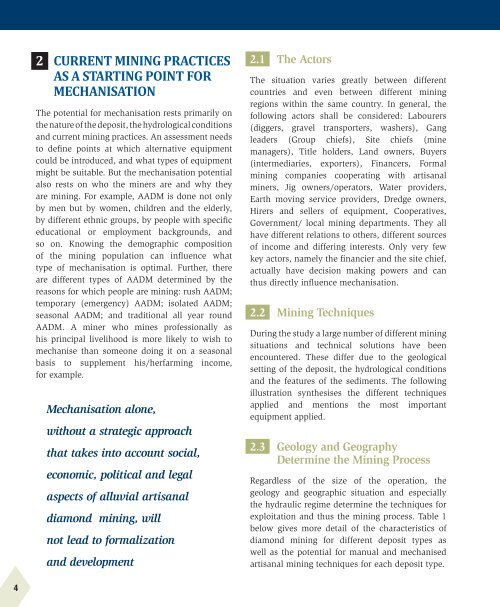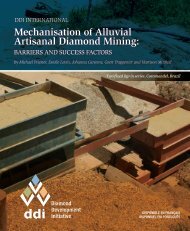Mechanisation-Alluvial-Artisanal-Diamond-Mining
Mechanisation-Alluvial-Artisanal-Diamond-Mining
Mechanisation-Alluvial-Artisanal-Diamond-Mining
Create successful ePaper yourself
Turn your PDF publications into a flip-book with our unique Google optimized e-Paper software.
2 Current <strong>Mining</strong> Practices<br />
as a starting Point for<br />
<strong>Mechanisation</strong><br />
The potential for mechanisation rests primarily on<br />
the nature of the deposit, the hydrological conditions<br />
and current mining practices. An assessment needs<br />
to define points at which alternative equipment<br />
could be introduced, and what types of equipment<br />
might be suitable. But the mechanisation potential<br />
also rests on who the miners are and why they<br />
are mining. For example, AADM is done not only<br />
by men but by women, children and the elderly,<br />
by different ethnic groups, by people with specific<br />
educational or employment backgrounds, and<br />
so on. Knowing the demographic composition<br />
of the mining population can influence what<br />
type of mechanisation is optimal. Further, there<br />
are different types of AADM determined by the<br />
reasons for which people are mining: rush AADM;<br />
temporary (emergency) AADM; isolated AADM;<br />
seasonal AADM; and traditional all year round<br />
AADM. A miner who mines professionally as<br />
his principal livelihood is more likely to wish to<br />
mechanise than someone doing it on a seasonal<br />
basis to supplement his/herfarming income,<br />
for example.<br />
<strong>Mechanisation</strong> alone,<br />
without a strategic approach<br />
that takes into account social,<br />
economic, political and legal<br />
aspects of alluvial artisanal<br />
diamond mining, will<br />
not lead to formalization<br />
and development<br />
2.1 The Actors<br />
The situation varies greatly between different<br />
countries and even between different mining<br />
regions within the same country. In general, the<br />
following actors shall be considered: Labourers<br />
(diggers, gravel transporters, washers), Gang<br />
leaders (Group chiefs), Site chiefs (mine<br />
managers), Title holders, Land owners, Buyers<br />
(intermediaries, exporters), Financers, Formal<br />
mining companies cooperating with artisanal<br />
miners, Jig owners/operators, Water providers,<br />
Earth moving service providers, Dredge owners,<br />
Hirers and sellers of equipment, Cooperatives,<br />
Government/ local mining departments. They all<br />
have different relations to others, different sources<br />
of income and differing interests. Only very few<br />
key actors, namely the financier and the site chief,<br />
actually have decision making powers and can<br />
thus directly influence mechanisation.<br />
2.2 <strong>Mining</strong> Techniques<br />
During the study a large number of different mining<br />
situations and technical solutions have been<br />
encountered. These differ due to the geological<br />
setting of the deposit, the hydrological conditions<br />
and the features of the sediments. The following<br />
illustration synthesises the different techniques<br />
applied and mentions the most important<br />
equipment applied.<br />
2.3 Geology and Geography<br />
Determine the <strong>Mining</strong> Process<br />
Regardless of the size of the operation, the<br />
geology and geographic situation and especially<br />
the hydraulic regime determine the techniques for<br />
exploitation and thus the mining process. Table 1<br />
below gives more detail of the characteristics of<br />
diamond mining for different deposit types as<br />
well as the potential for manual and mechanised<br />
artisanal mining techniques for each deposit type.<br />
4



